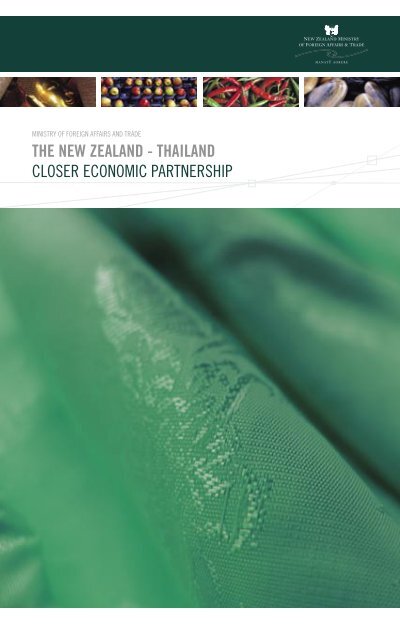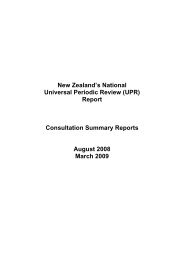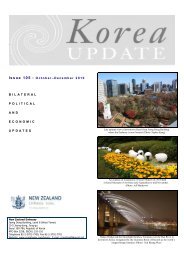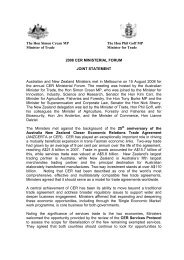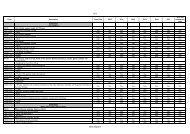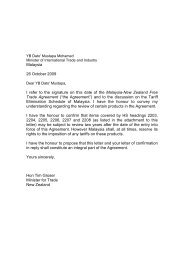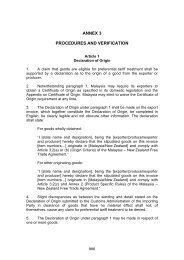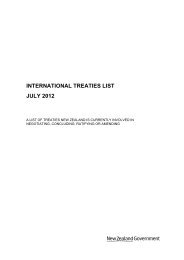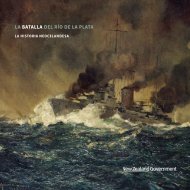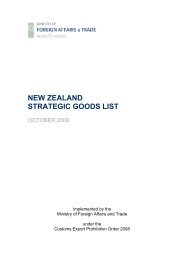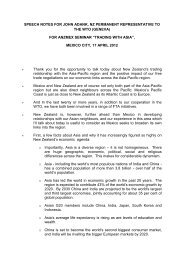The New Zealand - Thailand Closer Economic Partnership Booklet
The New Zealand - Thailand Closer Economic Partnership Booklet
The New Zealand - Thailand Closer Economic Partnership Booklet
Create successful ePaper yourself
Turn your PDF publications into a flip-book with our unique Google optimized e-Paper software.
MINISTRY OF FOREIGN AFFAIRS AND TRADE<br />
THE NEW ZEALAND - THAILAND<br />
CLOSER ECONOMIC PARTNERSHIP
<strong>The</strong> Ministry of Foreign Affairs and Trade thanks the<br />
following individuals, companies and organisations for the<br />
use of photographs in this publication: Lyndal Walker,<br />
Catherine Parton, Janet Morris, Paul Thomson,<br />
Photo<strong>New</strong><strong>Zealand</strong>.com, Stone, Photodisc Blue,<br />
Education <strong>New</strong> <strong>Zealand</strong>, Tourism <strong>New</strong> <strong>Zealand</strong><br />
and <strong>New</strong> <strong>Zealand</strong> Trade and Enterprise.<br />
Design by typeface, Wellington<br />
Printed by Printlink, Wellington<br />
This Ministry of Foreign Affairs and Trade publication<br />
provides an overview and a practical business guide to<br />
the <strong>New</strong> <strong>Zealand</strong> – <strong>Thailand</strong> <strong>Closer</strong> <strong>Economic</strong> <strong>Partnership</strong>.<br />
A full copy of the Agreement and associated documents can<br />
be obtained at www.mfat.govt.nz/tradeagreements/thainzcep/<br />
overview.html. <strong>New</strong> <strong>Zealand</strong> Trade and Enterprise is<br />
producing a sister publication titled Doing Business with<br />
<strong>Thailand</strong> – a how to guide.<br />
Ministry of Foreign Affairs and Trade<br />
Private Bag 18-901<br />
Wellington<br />
<strong>New</strong> <strong>Zealand</strong><br />
www.mfat.govt.nz<br />
© Copyright Ministry of Foreign Affairs and Trade 2005<br />
All rights reserved.<br />
Permission to reproduce any part of this publication must be<br />
obtained in writing from the Ministry of Foreign Affairs and<br />
Trade. <strong>The</strong> Ministry of Foreign Affairs and Trade shall not be<br />
under any liability to any person or organisation in respect of<br />
any loss or damage (including consequential loss or damage)<br />
however caused, which may be incurred or which arises directly<br />
or indirectly from reliance on information in this publication.<br />
ISBN 0-477-03790-9
MINISTRY OF FOREIGN AFFAIRS AND TRADE<br />
THE NEW ZEALAND - THAILAND<br />
CLOSER ECONOMIC PARTNERSHIP<br />
www.mfat.govt.nz
FROM THE MINISTER OF TRADE NEGOTIATIONS >><br />
THE NEW ZEALAND-THAILAND CLOSER ECONOMIC<br />
PARTNERSHIP (CEP) USHERS IN A NEW ERA IN ECONOMIC<br />
RELATIONS BETWEEN THE TWO COUNTRIES. IT OPENS UP<br />
EXCITING OPPORTUNITIES FOR EXPORTERS AND FOR WIDER<br />
BUSINESS PARTNERSHIPS BETWEEN NEW ZEALAND AND<br />
ONE OF THE MOST DYNAMIC ECONOMIES IN OUR REGION.<br />
2
<strong>The</strong> <strong>New</strong> <strong>Zealand</strong>-<strong>Thailand</strong> <strong>Closer</strong> <strong>Economic</strong><br />
<strong>Partnership</strong> (CEP) ushers in a new era in economic<br />
relations between the two countries. It opens up<br />
exciting opportunities for exporters and for wider<br />
business partnerships between <strong>New</strong> <strong>Zealand</strong> and<br />
one of the most dynamic economies in our region.<br />
I am particularly proud of this Agreement because<br />
it provides for comprehensive coverage of all goods<br />
traded between <strong>New</strong> <strong>Zealand</strong> and <strong>Thailand</strong>.<br />
<strong>The</strong> CEP opens up the Thai market. It clears<br />
the way for duty-free access on more than half<br />
<strong>New</strong> <strong>Zealand</strong>’s current exports on the very day<br />
it comes into effect – 1 July 2005. Within five years<br />
tariffs on virtually all manufactured goods will have<br />
disappeared. <strong>The</strong> last remaining tariffs and quotas<br />
will go by 2025.<br />
This provides a significant opportunity for exporters<br />
of products as diverse as persimmons and gas<br />
pumps. <strong>New</strong> market opportunities will be created<br />
with the elimination of prohibitive tariffs, and<br />
current exporters will have the inside running<br />
to expand market share.<br />
Just as importantly the CEP will help to keep<br />
a level playing field for <strong>New</strong> <strong>Zealand</strong> exporters<br />
competing with suppliers from <strong>Thailand</strong>’s other<br />
free trade partners.<br />
<strong>The</strong> Agreement is a big step forward to enhancing<br />
the economic relationship between our two<br />
countries but it is not the end of the road.<br />
<strong>The</strong>re is an undertaking to enter into negotiations<br />
on the liberalisation of trade in services within<br />
three years.<br />
<strong>The</strong> <strong>New</strong> <strong>Zealand</strong>-<strong>Thailand</strong> <strong>Closer</strong> <strong>Economic</strong><br />
<strong>Partnership</strong> enhances a multi-layered bilateral<br />
relationship dating back to the 1950s, while<br />
at the same time maintaining momentum towards<br />
multilateral trade liberalisation in the World Trade<br />
Organisation (WTO).<br />
Now we have an agreement with <strong>Thailand</strong>, the<br />
government wants to work with business to<br />
maximise the benefits and opportunities it offers.<br />
It is only by government agencies and the wider<br />
business community ‘pulling together’ as one that<br />
we will collectively harvest the gains made within<br />
the fine print of the <strong>Closer</strong> <strong>Economic</strong> <strong>Partnership</strong>.<br />
Jim Sutton<br />
3
CONTENTS<br />
1 WHAT IS THE NEW ZEALAND-THAILAND CLOSER ECONOMIC PARTNERSHIP? 8<br />
2 THE PATH TO THE AGREEMENT 10<br />
3 WHY THAILAND? 12<br />
4 THE NEW ZEALAND-THAILAND CLOSER ECONOMIC PARTNERSHIP<br />
AND THE WIDER TRADE AGENDA 14<br />
5 FREE TRADE IN GOODS 16<br />
Opening up the Thai market 17<br />
Thai tariff reductions by sector 18<br />
Dairy 18<br />
Fruit and vegetables 20<br />
Forestry products 22<br />
Seafood 22<br />
Meat 24<br />
Processed food and beverages/food ingredients 24<br />
Manufactured goods 26<br />
Opening up the <strong>New</strong> <strong>Zealand</strong> market 28<br />
Sensitive products 28<br />
Phasing-out of tariffs on Thai imports 28<br />
Rules governing the free trade area 30<br />
Rules of origin 30<br />
Trade remedies 31<br />
6 MEASURES TO IMPROVE THE BUSINESS ENVIRONMENT 32<br />
Customs procedures 32<br />
Sanitary and phytosanitary measures 33<br />
Technical barriers to trade 33<br />
Electronic commerce 33<br />
Intellectual property 34<br />
Competition policy 34<br />
Transparency 34<br />
4
7 SERVICES AND TEMPORARY ENTRY 36<br />
Services 36<br />
Temporary entry for business visitors 36<br />
Temporary employment 37<br />
8 INVESTMENT 38<br />
9 DISPUTE SETTLEMENT 40<br />
10 PROTECTIONS UNDER THE AGREEMENT 41<br />
General exceptions 41<br />
Treaty of Waitangi 41<br />
11 MOVING FORWARD 42<br />
Joint Commission 42<br />
Reviews 43<br />
Future negotiations 43<br />
12 HARVESTING THE CEP POTENTIAL 44<br />
13 THE LABOUR AND ENVIRONMENT ARRANGEMENTS 46<br />
Cooperation and Institutional Arrangements 47<br />
Public participation 47<br />
FOR MORE INFORMATION 48<br />
5
NEW ZEALAND < > THAILAND CLOSER ECONOMIC PARTNERSHIP<br />
1<br />
WHAT IS THE NEW ZEALAND-THAILAND<br />
CLOSER ECONOMIC PARTNERSHIP?<br />
<strong>The</strong> <strong>New</strong> <strong>Zealand</strong>-<strong>Thailand</strong> <strong>Closer</strong> <strong>Economic</strong><br />
<strong>Partnership</strong> (CEP) Agreement is a treaty which<br />
liberalises and facilitates trade, establishes<br />
rules for the trade and investment relationship<br />
and promotes cooperation across a broad<br />
spectrum of economic activities.<br />
<strong>The</strong> key elements of the Agreement outlined here<br />
are described in more detail in the remainder of<br />
this guide.<br />
<strong>The</strong> core commitment in the CEP is the<br />
establishment of a free trade area between<br />
<strong>New</strong> <strong>Zealand</strong> and <strong>Thailand</strong>. Both countries have<br />
undertaken to remove all tariffs and quotas on<br />
all goods over time. <strong>The</strong>re will be substantial<br />
liberalisation immediately the Agreement is<br />
implemented. For more sensitive areas tariffs<br />
will be phased out over a longer period.<br />
<strong>The</strong> CEP contains rules governing the free trade<br />
area. <strong>The</strong>se include rules to determine which goods<br />
qualify for tariff preferences (the ‘rules of origin’) as<br />
well as rules to counter unfair trade or unexpected<br />
import surges between the two countries.<br />
<strong>The</strong>re are measures in the CEP designed to improve<br />
the business environment between <strong>New</strong> <strong>Zealand</strong><br />
and <strong>Thailand</strong>, reduce the cost of doing business,<br />
and promote cooperation. <strong>The</strong>se are in areas such<br />
as technical barriers to trade and customs procedures.<br />
8
<strong>The</strong> undertaking to conclude an agreement<br />
liberalising trade in services is accompanied by an<br />
exchange of letters on temporary entry to <strong>Thailand</strong><br />
for <strong>New</strong> <strong>Zealand</strong> business people. Separately,<br />
<strong>New</strong> <strong>Zealand</strong> has offered enhanced temporary<br />
employment access for qualified Thai chefs.<br />
Rules and initial commitments are established<br />
on investment.<br />
<strong>The</strong> CEP establishes robust bilateral dispute<br />
settlement mechanisms. It also contains certain<br />
protections which preserve governments’ regulatory<br />
and policy-making flexibility.<br />
Importantly, the CEP establishes a framework<br />
for taking the economic relationship forward, both<br />
through the bilateral institutions it sets up and<br />
through scheduled reviews and future negotiations.<br />
Parallel with the agreement, <strong>New</strong> <strong>Zealand</strong> and<br />
<strong>Thailand</strong> have entered into Arrangements on Labour<br />
and Environment.<br />
9
NEW ZEALAND < > THAILAND CLOSER ECONOMIC PARTNERSHIP<br />
2 THE PATH TO THE AGREEMENT<br />
Prime Minister Helen Clark and Thai Prime<br />
Minister Thaksin Shinawatra launched the<br />
CEP process at the APEC Leaders’ Summit<br />
in Bangkok in October 2003.<br />
<strong>The</strong> Agreement was negotiated over six months<br />
in the second half of 2004 following a joint study<br />
by <strong>Thailand</strong> and <strong>New</strong> <strong>Zealand</strong>.<br />
<strong>The</strong> two Prime Ministers announced the successful<br />
conclusion of these negotiations at the ASEAN<br />
Summit in Vientiane on 30 November 2004.<br />
Minister for Trade Negotiations Jim Sutton and<br />
Thai Commerce Minister Dr Thanong Bidaya signed<br />
the Agreement in the presence of Prime Ministers<br />
Helen Clark and Thaksin Shinawatra in Bangkok<br />
on 19 April 2005.<br />
10
<strong>The</strong> CEP will be implemented on 1 July 2005<br />
following completion of both countries’ processes<br />
for bringing the Agreement into force.<br />
LEFT: Prime Minister Helen Clark and Thai Prime Minister<br />
H E Dr Thaksin Shinawatra inspect the guard of honour<br />
prior to the formal signing of the <strong>New</strong> <strong>Zealand</strong>-<strong>Thailand</strong><br />
<strong>Closer</strong> <strong>Economic</strong> <strong>Partnership</strong> Agreement on 19 April 2005.<br />
BELOW: Trade Negotiations Minister Jim Sutton and Thai<br />
Commerce Minister Dr Thanong Bidaya, watched by their<br />
respective Prime Ministers, sign the <strong>New</strong> <strong>Zealand</strong>-<strong>Thailand</strong><br />
<strong>Closer</strong> <strong>Economic</strong> <strong>Partnership</strong> Agreement in Bangkok<br />
on 19 April 2005.<br />
11
NEW ZEALAND < > THAILAND CLOSER ECONOMIC PARTNERSHIP<br />
3 WHY THAILAND?<br />
<strong>New</strong> <strong>Zealand</strong> has strong interest in forging<br />
closer economic links with <strong>Thailand</strong>, and<br />
in doing so now.<br />
<strong>Thailand</strong> is South East Asia’s fastest-growing<br />
economy with growth in 2004 of 6.2 percent. Strong<br />
growth is projected to continue, fueled by domestic<br />
investment and international trade.<br />
<strong>Thailand</strong> is enthusiastically pursuing free trade<br />
agreements (FTAs) that will add to trade flows and<br />
make <strong>Thailand</strong> more competitive.<br />
<strong>Thailand</strong> is an increasingly important business hub<br />
for the Greater Mekong sub-region and the wider<br />
South East Asia region.<br />
<strong>New</strong> <strong>Zealand</strong> and <strong>Thailand</strong>’s longstanding, friendly<br />
relationship provides a sound basis for doing<br />
business together. <strong>The</strong> alumni of <strong>New</strong> <strong>Zealand</strong><br />
educational institutions in <strong>Thailand</strong> will support<br />
the expansion of the economic relationship.<br />
<strong>Thailand</strong> and <strong>New</strong> <strong>Zealand</strong> are largely<br />
complementary economies, making us natural<br />
CEP partners. <strong>Thailand</strong> exports mainly motor vehicles<br />
and electronic goods to <strong>New</strong> <strong>Zealand</strong> while<br />
<strong>New</strong> <strong>Zealand</strong>’s exports are concentrated in<br />
agriculture-based products and niche manufactured<br />
goods. Two-way trade topped NZ$1 billion in 2004, 1<br />
with <strong>New</strong> <strong>Zealand</strong> exports to <strong>Thailand</strong> accounting<br />
for $365 million of this total.<br />
1<br />
Statistics <strong>New</strong> <strong>Zealand</strong> provisional 2004 figure.<br />
12
<strong>Thailand</strong> has maintained some of the highest trade<br />
barriers in the South East Asia region. It is a market<br />
where tariffs and quotas impede <strong>New</strong> <strong>Zealand</strong><br />
exports. Tariffs on <strong>New</strong> <strong>Zealand</strong> products average<br />
nine percent and for many goods are as high as<br />
40 to 60 percent. By removing all these barriers over<br />
time, and many of them immediately, the CEP will<br />
open up significant opportunities for <strong>New</strong> <strong>Zealand</strong><br />
and <strong>Thailand</strong> to develop their trading relationship<br />
to full potential.<br />
Without this agreement, <strong>New</strong> <strong>Zealand</strong> would<br />
be significantly disadvantaged in the Thai market<br />
due to the preferential entry given to <strong>Thailand</strong>’s<br />
current FTA partners, China, Australia and ASEAN,<br />
and future partners including the United States<br />
and Japan.<br />
13
NEW ZEALAND < > THAILAND CLOSER ECONOMIC PARTNERSHIP<br />
THE NEW ZEALAND-THAILAND CLOSER ECONOMIC<br />
4 PARTNERSHIP AND THE WIDER TRADE AGENDA<br />
At no time in recent history has there been<br />
so much activity in the global trade negotiating<br />
environment. World trade talks and multiple<br />
bilateral and regional free trade agreements<br />
are all progressing simultaneously.<br />
<strong>The</strong> multilateral World Trade Organisation (WTO)<br />
process remains the top trade priority for<br />
<strong>New</strong> <strong>Zealand</strong> because it offers the largest potential<br />
gains. But the scale of the negotiations and the<br />
interests involved means that progress is slow.<br />
While the WTO Doha Round continues,<br />
<strong>New</strong> <strong>Zealand</strong> recognises that closer economic<br />
partnerships (CEPs) and free trade agreements<br />
(FTAs) can open up important new opportunities<br />
for <strong>New</strong> <strong>Zealand</strong> exporters in a shorter timeframe<br />
than through the WTO. <strong>The</strong>y allow <strong>New</strong> <strong>Zealand</strong><br />
to accelerate progress towards more open markets<br />
by partnering with countries that share our same<br />
level of determination for progress.<br />
14
Good quality FTAs can also usefully contribute<br />
to moving the WTO and Asia Pacific <strong>Economic</strong><br />
Cooperation (APEC) processes forward by<br />
highlighting the benefits of liberalisation.<br />
CEPs and FTAs are under negotiation by most of<br />
our trading partners and have proliferated around<br />
the world – particularly in the Asia region. It is<br />
essential that <strong>New</strong> <strong>Zealand</strong> is part of this activity<br />
to strengthen economic links and obtain improved<br />
access to markets.<br />
15
NEW ZEALAND < > THAILAND CLOSER ECONOMIC PARTNERSHIP<br />
5 FREE TRADE IN GOODS<br />
<strong>The</strong> CEP establishes a free trade area between<br />
<strong>New</strong> <strong>Zealand</strong> and <strong>Thailand</strong>. Both countries<br />
have agreed to remove all tariffs and quotas<br />
on all goods. Much of this liberalisation takes<br />
place when the agreement kicks off. For more<br />
sensitive areas tariffs are phased out over<br />
a longer period.<br />
<strong>The</strong> initial tariff cuts will take place upon<br />
implementation of the CEP on 1 July 2005<br />
and the second round will follow on 1 January<br />
2006. Subsequent tariff reductions will be applied<br />
on 1 January each year.<br />
<strong>The</strong>re is scope within the agreement for<br />
negotiations to accelerate tariff reductions<br />
in the future.<br />
Comprehensive details of changes to tariffs and<br />
the timetables for these changes are set out in<br />
the <strong>New</strong> <strong>Zealand</strong> and <strong>Thailand</strong> Tariff Schedules.<br />
<strong>The</strong>y form Annex 1 of the Agreement. <strong>The</strong>se<br />
schedules are available online at:<br />
>> www.mfat.govt.nz/tradeagreements/thainzcep/<br />
cepindex.html<br />
16
OPENING UP THE THAI MARKET<br />
Once implemented, the <strong>Closer</strong> <strong>Economic</strong> <strong>Partnership</strong><br />
will dramatically increase the proportion of<br />
<strong>New</strong> <strong>Zealand</strong> exports entering duty-free into<br />
<strong>Thailand</strong>, as illustrated.<br />
Virtually all <strong>New</strong> <strong>Zealand</strong> exports to <strong>Thailand</strong> are<br />
currently subject to tariffs. Once in force the CEP<br />
will provide duty-free access for more than half<br />
<strong>New</strong> <strong>Zealand</strong>’s current exports. <strong>The</strong> remaining<br />
barriers will phase out in stages, with the last<br />
tariffs and quotas removed in 2025.<br />
Details of the arrangements for liberalising<br />
<strong>Thailand</strong>’s tariff quotas on certain agricultural<br />
products are set out in Annex 1.3 of the Agreement.<br />
This is available online at:<br />
>> www.mfat.govt.nz/tradeagreements/thainzcep/<br />
annex1.3.html<br />
Percent<br />
PERCENTAGE OF NEW ZEALAND EXPORTS TO THAILAND<br />
(subject to duties)<br />
100<br />
80<br />
60<br />
40<br />
20<br />
0<br />
1 Jan<br />
2005<br />
1 July<br />
2005<br />
Based on 2002-2004 imports<br />
1 Jan<br />
2010<br />
1 Jan<br />
2015<br />
1 Jan<br />
2020<br />
1 Jan<br />
2025<br />
<strong>The</strong>re are some products exported to <strong>Thailand</strong> that<br />
will be subject to a special agricultural safeguard<br />
marked as ‘SSG’ in <strong>Thailand</strong>’s Tariff Schedule.<br />
<strong>The</strong> operation of these safeguards is explained<br />
in the Trade Remedies section.<br />
17
NEW ZEALAND < > THAILAND CLOSER ECONOMIC PARTNERSHIP<br />
“<br />
THIS IS A SUBSTANTIAL AGREEMENT FOR THE<br />
NEW ZEALAND DAIRY INDUSTRY. IT IS VERY IMPORTANT<br />
BECAUSE IT WILL RE-ESTABLISH A LEVEL PLAYING FIELD<br />
WITH AUSTRALIA IN THE MARKET NOT LONG AFTER<br />
AUSTRALIA’S FREE TRADE AGREEMENT WITH THAILAND<br />
ENTERS INTO FORCE.<br />
Fonterra<br />
”<br />
THAI TARIFF REDUCTIONS BY SECTOR<br />
Dairy<br />
Dairy exports, worth $214.3 million in 2004, account<br />
for 58 percent of <strong>New</strong> <strong>Zealand</strong> trade with <strong>Thailand</strong>.<br />
Generally speaking, imported dairy products<br />
complement domestic production of fresh milk.<br />
Many imported dairy products are ingredients<br />
for <strong>Thailand</strong>’s food processing sector. Nevertheless<br />
this was the most sensitive sector for <strong>Thailand</strong><br />
in the negotiation. It is subject to the longest<br />
phase-outs under the Agreement.<br />
<strong>The</strong> CEP offers substantial benefits to dairy<br />
exporters. Benefits come in the medium to long<br />
term from the phased elimination of all tariffs<br />
and quotas. Among the short-term benefits is the<br />
immediate elimination of the five percent tariff<br />
on infant milk food. This is <strong>New</strong> <strong>Zealand</strong>’s single<br />
largest export to <strong>Thailand</strong>.<br />
18
TARIFF REDUCTIONS: DAIRY<br />
PRODUCT<br />
EXPORTS<br />
(NZ$ AV. 2002- 04)<br />
CURRENT TARIFF<br />
PHASE-OUT<br />
Infant milk food 57,611,301 5% 1/7/2005<br />
Skim milk powder 56,360,809 5% 2 Tariff and quota removed<br />
1/1/2025<br />
Whole milk powder 51,279,024 18% Reduces to 15% 1/7/2005,<br />
phases to zero 1/1/2020 (SSG)<br />
Butterfat 17, 515,190 5% Eliminated 1/1/2008<br />
Buttermilk 17,150,720 18% Reduces to 15% 1/7/2005,<br />
phases to zero 1/1/2015 (SSG)<br />
Cheese 5,171,552 30% Phases to zero 1/1/2020 (SSG)<br />
Sweetened whole<br />
milk powder<br />
2,395,689 18% Reduces to 15% 1/7/2005,<br />
phases to zero 1/1/2020 (SSG)<br />
Other dairy preparations 1,805,077 5% Eliminated 1/7/2005<br />
Milk powder for<br />
infant feeding<br />
1,593,317 5% Eliminated 1/7/2005<br />
Caseinates 561,921 5% Eliminated 1/7/2005<br />
Lactose 380,789 1%/10% Eliminated 1/7/2005<br />
Butter 372,847 30% Phases to zero 1/1/2020 (SSG)<br />
Whey 248,559 5% Reduces to 3% 1/1/2008,<br />
eliminated 1/1/2009 (SSG)<br />
Evaporated milk 210,254 30% Phases to zero 1/1/2015 (SSG)<br />
Liquid milk and cream 11,579 20%/41% Tariff and quota removed<br />
1/1/2025 3<br />
2<br />
5% is the current applied in-quota tariff. <strong>The</strong> bound in-quota tariff is 20%.<br />
<strong>The</strong> out-of quota tariff is 216%. An in-quota tariff applies to exports<br />
within a set annual quota. However provisions allow for this tariff to rise<br />
to a set maximum, known as a bound in-quota tariff. An out-of-quota tariff<br />
applies to exports above and beyond the set annual quota.<br />
3<br />
Liquid milk and cream are currently subject to a tariff quota with an<br />
in-quota tariff of 20% and an out-of-quota tariff of 41%. <strong>Thailand</strong> will<br />
establish a <strong>New</strong> <strong>Zealand</strong>-specific quota of 120 tonnes, which will expand<br />
by 17% every five years at the same time as the tariff reduces progressively.<br />
19
NEW ZEALAND < > THAILAND CLOSER ECONOMIC PARTNERSHIP<br />
“<br />
THE DRAMATIC REDUCTION IN TARIFFS SHOULD<br />
SEE EXPORTS TO THAILAND GROW AS PRICES TO THE<br />
CONSUMER FALL. THAILAND HAS A POPULATION OF<br />
64 MILLION AND A DYNAMIC ECONOMY, WITH A<br />
GROWING NUMBER OF AFFLUENT PEOPLE WANTING<br />
GOOD QUALITY, SAFE FOOD.<br />
Horticulture Export Authority<br />
”<br />
Fruit and vegetables<br />
<strong>Thailand</strong> has restrictive tariffs, mostly in the<br />
range of 30-40 percent, on imports of fruits and<br />
vegetables, with many products attracting specific<br />
duties by weight. On top of this, tariff quotas<br />
restrict imports of onions and potatoes.<br />
<strong>The</strong> CEP makes radical and immediate changes<br />
to the exporting environment for the horticulture<br />
industry.<br />
<strong>The</strong> immediate elimination of tariffs on most fruit<br />
and vegetable exports will put <strong>New</strong> <strong>Zealand</strong><br />
exporters on the same footing as Chinese suppliers<br />
in the Thai market. China has had duty-free access<br />
to <strong>Thailand</strong> since October 2003.<br />
Access to the Thai market will also improve<br />
under the CEP for a number of other products.<br />
In particular, the 40 percent tariffs on avocados,<br />
sweet potatoes and frozen mixed vegetables will<br />
be eliminated immediately.<br />
Fresh potatoes, like onions, are subject to a<br />
tariff quota with an in-quota tariff of 27 percent.<br />
<strong>The</strong> out-of-quota tariff for potatoes is 125 percent.<br />
<strong>New</strong> <strong>Zealand</strong> has not so far exported potatoes<br />
in any quantity, partly due to <strong>Thailand</strong>’s current<br />
requirement for potatoes to be washed prior<br />
to export.<br />
20
A small <strong>New</strong> <strong>Zealand</strong>-specific quota for potatoes of<br />
30.2 tonnes will be established under the CEP and<br />
increase by five percent annually. For this quantity,<br />
the tariff will reduce progressively. From 1 January<br />
2020 <strong>New</strong> <strong>Zealand</strong> potatoes will have tariff and<br />
quota-free access to <strong>Thailand</strong>.<br />
Under the exchange of letters on sanitary and<br />
phytosanitary (SPS) issues, <strong>Thailand</strong> will address<br />
<strong>New</strong> <strong>Zealand</strong>’s request for alternative measures<br />
to the current washing requirement for potato<br />
imports.<br />
TARIFF REDUCTIONS: HORTICULTURE<br />
PRODUCT<br />
EXPORTS<br />
(NZ$ AV. 2002-04)<br />
CURRENT TARIFF<br />
PHASE-OUT<br />
Apples 3,895,698 10% Eliminated 1/7/2005<br />
Carrots 1,135,630 40% Eliminated 1/7/2005<br />
Dried peas 435,422 30% Eliminated 1/7/2005<br />
Persimmons 400,369 30% or 33.5 baht/kg Eliminated 1/7/2005<br />
Frozen peas 359,203 40% Eliminated 1/7/2005<br />
Kiwifruit 139,876 30% or 25 baht/kg Eliminated 1/7/2005<br />
Cherries 110,100 40% Eliminated 1/7/2005<br />
Onions 100,779 142% out of quota<br />
27% in-quota<br />
NZ-specific quota of 36.5<br />
tonnes per annum established<br />
and expands by 5% per annum.<br />
In-quota tariff phases to zero<br />
on 1/1/2020, at which point<br />
all restrictions are lifted.<br />
21
NEW ZEALAND < > THAILAND CLOSER ECONOMIC PARTNERSHIP<br />
Forestry products<br />
While unprocessed wood entering <strong>Thailand</strong> faces<br />
relatively low barriers, the tariffs escalate for<br />
value-added products such as fibreboard and<br />
plywood. <strong>Thailand</strong> treated these as sensitive<br />
products in the negotiation with <strong>New</strong> <strong>Zealand</strong>.<br />
<strong>The</strong> CEP will immediately remove the one percent<br />
tariff on a number of less processed but high<br />
volume <strong>New</strong> <strong>Zealand</strong> forest products exported<br />
to <strong>Thailand</strong>.<br />
For <strong>New</strong> <strong>Zealand</strong> exporters to <strong>Thailand</strong>’s more<br />
heavily protected joinery and furniture component<br />
sectors, the Agreement will provide some<br />
immediate tariff cuts and full free trade over time.<br />
Seafood<br />
<strong>New</strong> <strong>Zealand</strong>’s seafood exports to <strong>Thailand</strong> are<br />
largely destined for <strong>Thailand</strong>’s world-leading fish<br />
processing export industry. Tariffs on these imports<br />
(including tuna, hoki and squid) are generally<br />
rebated under <strong>Thailand</strong>’s duty drawback<br />
arrangements for re-exported goods.<br />
But <strong>Thailand</strong> maintains significant tariff barriers<br />
on seafood imports for domestic consumption.<br />
It treated some seafood imports as sensitive items<br />
in the negotiation.<br />
Some of these tariffs will be eliminated<br />
immediately, while tariff phase-outs will improve<br />
opportunities for other products in the medium term.<br />
22
TARIFF REDUCTIONS: FORESTRY PRODUCTS<br />
PRODUCT<br />
EXPORTS<br />
(NZ$ AV. 2002-04)<br />
CURRENT TARIFF<br />
PHASE-OUT<br />
Sawn timber 19,899,994 1% Eliminated 1/7/2005<br />
Wood pulp 9,326,570 1% Eliminated 1/7/2005<br />
<strong>New</strong>sprint (weighing<br />
not more than 55g/m2)<br />
5,063,431 0.33 baht/kg Eliminated 1/7/2005<br />
Logs 3,206,167 1% Eliminated 1/7/2005<br />
Fibreboard 497,525 12.5% Cut to 5% 1/7/2005,<br />
eliminated 1/1/2012<br />
Particle board 139,881 12.5 % Cut to 6.25% 1/1/2010,<br />
eliminated 1/1/2015<br />
Plywood 30,369 12.5% Cut to 6.25% 1/7/2005,<br />
phases to zero 1/1/2010<br />
TARIFF REDUCTIONS: SEAFOOD<br />
PRODUCT<br />
EXPORTS<br />
(NZ$ AV. 2002-04)<br />
CURRENT TARIFF<br />
PHASE-OUT<br />
Frozen tuna 8,133,889 5% (duty drawback<br />
applies to re-exports)<br />
Eliminated 1/7/2005<br />
Other frozen fish (mackerel,<br />
hoki, ling, deepsea dories,<br />
alfonsino etc)<br />
6,562,125 5% (duty drawback<br />
applies to re-exports)<br />
Reduces to 4% 1/1/2011,<br />
phases to zero 1/1/2015<br />
Frozen fish fillets 909,577 5% Reduces to 4% 1/1/2011,<br />
phases to zero 1/1/2015<br />
Frozen scampi 871,635 5% Eliminated 1/7/2005<br />
Mussels and oysters 568,736 5% Reduces to 3% 1/1/2008,<br />
eliminated 1/1/2009<br />
Frozen squid 237,450 5% (duty drawback<br />
applies to re-exports)<br />
Eliminated 1/7/2005<br />
Processed mussels 46,875 20% Eliminated 1/7/2005<br />
23
NEW ZEALAND < > THAILAND CLOSER ECONOMIC PARTNERSHIP<br />
Meat<br />
<strong>Thailand</strong> currently imports only small quantities<br />
of red meat. This is due to a combination of factors<br />
including trade barriers and consumption patterns.<br />
<strong>New</strong> <strong>Zealand</strong> supplies 22 percent of current red<br />
meat imports to <strong>Thailand</strong>. Opportunities are<br />
increasing as demand for high quality red meat<br />
grows, especially from <strong>Thailand</strong>’s hotel and<br />
tourism sector.<br />
Domestic industry sensitivities in <strong>Thailand</strong> mean<br />
that market opening under the CEP is gradual, and<br />
subject to special safeguards. <strong>New</strong> <strong>Zealand</strong> meat<br />
exporters nevertheless stand to benefit, particularly<br />
from cumulative reductions in the high tariffs<br />
on beef.<br />
Processed food and beverages/<br />
food ingredients<br />
Tariff reductions on processed food and beverages<br />
and ingredients for the large Thai food-processing<br />
sector are expected to open up opportunities for<br />
both current and new exporters.<br />
Of particular relevance to new exporters is the<br />
immediate elimination of the 30 percent tariff<br />
on certain fruit-based products, which are currently<br />
shut out of the market.<br />
<strong>The</strong> significant upfront reductions in tariffs on wine<br />
and spirits should enable <strong>New</strong> <strong>Zealand</strong> exporters<br />
to build on their current small foothold.<br />
24
TARIFF REDUCTIONS: MEAT<br />
PRODUCT<br />
EXPORTS<br />
(NZ$ AV. 2002-04)<br />
CURRENT TARIFF<br />
PHASE-OUT<br />
Beef 616,347 50% Cut to 40% 1/7/2005,<br />
phases to zero 1/1/2020 (SSG)<br />
Beef offal 280,199 30% Phases to zero 1/1/2020 (SSG)<br />
Sheepmeat 477,183 30% Cut to 24% 1/7/2005,<br />
phases to zero 1/1/2010<br />
TARIFF REDUCTIONS: PROCESSED FOOD & BEVERAGE<br />
PRODUCT<br />
EXPORTS<br />
(NZ$ AV. 2002-04)<br />
CURRENT TARIFF<br />
PHASE-OUT<br />
Processed frozen potatoes 3,423,858 30% or 25 baht/kg Reduces to 24% 1/7/2005,<br />
phases to zero 1/1/2015 (SSG)<br />
Other sugars/<br />
honey powder<br />
Denatured ethyl alcohol<br />
and other spirits<br />
532,563 30% Reduces to 24% 1/7/2005,<br />
phases to zero 1/1/2010<br />
380,975 2.5 baht/litre Reduces to 6% 1/7/2005,<br />
removed 1/1/2009<br />
Spirits and liqueurs 251,008 60% or 120 baht/litre Reduces to 30% 1/7/2005,<br />
phases to zero 1/1/2010<br />
Wine 117,708 60% Reduces to 30% 1/7/2005,<br />
phases to zero 1/1/2015<br />
25
NEW ZEALAND < > THAILAND CLOSER ECONOMIC PARTNERSHIP<br />
Manufactured goods<br />
<strong>The</strong> CEP offers particular opportunities for<br />
exporters of manufactured goods. Tariffs will<br />
be eliminated immediately on 78 percent of current<br />
manufactured exports.<br />
<strong>The</strong> remaining tariffs will virtually all phase out by<br />
2010, resulting in free trade in manufactured goods<br />
well before this is achieved for primary products.<br />
<strong>The</strong> table opposite illustrates the impact of the<br />
CEP on a range of manufactured goods currently<br />
exported to <strong>Thailand</strong>.<br />
<strong>The</strong> CEP opens up fresh opportunities for some<br />
other goods where Thai tariffs have so far proved<br />
prohibitive, such as air conditioners.<br />
26
TARIFF REDUCTIONS: MANUFACTURED GOODS<br />
PRODUCT<br />
EXPORTS<br />
(NZ$ AV. 2002-04)<br />
CURRENT TARIFF<br />
PHASE-OUT<br />
Aluminium foil 2,249,267 7.5% Cut to 5% 1/7/2005,<br />
eliminated 1/1/2007<br />
Plastic sacks and bags 2,130,941 30% Cut to 15% 1/7/2005,<br />
phases to zero 1/1/2010<br />
Gas pumps 1,778,388 15% Eliminated 1/7/2005<br />
Telephonic/telegraphic<br />
switching apparatus<br />
Plastic plates, sheets,<br />
film etc<br />
Regulating or controlling<br />
instruments/apparatus<br />
Transmission apparatus<br />
for radio-telephony etc<br />
1,507,012 3% Eliminated 1/7/2005<br />
1,271,847 30% Cut to 15% 1/7/2005,<br />
phases to zero 1/1/2010<br />
985,647 10% Eliminated 1/7/2005<br />
764,173 3% Eliminated 1/7/2005<br />
Conveyor belts 420,884 20% Eliminated 1/7/2005<br />
Electrical machines<br />
and apparatus with<br />
individual functions<br />
Makeup and<br />
skincare products<br />
350,817 15% Cut to 7.5% 1/7/2005,<br />
phases to zero 1/1/2009<br />
243,557 40% Cut to 20% 1/7/2005,<br />
phases to zero 1/1/2010<br />
Plastic moulding equipment 177,866 5% Eliminated 1/7/2005<br />
TARIFF REDUCTIONS: MISCELLANEOUS OTHER PRODUCTS<br />
PRODUCT<br />
EXPORTS<br />
(NZ$ AV. 2002-04)<br />
CURRENT TARIFF<br />
PHASE-OUT<br />
Yarn 3,118,254 5% Eliminated 1/7/2005<br />
Petroleum oil 1,628,376 10% Eliminated 1/7/2005<br />
Salt 183,864 10% or 1.85 baht/kg Cut to 5% 1/7/2005,<br />
eliminated 1/1/2009<br />
Sphagnum moss 96,951 30% Cut to 12% 1/7/2005,<br />
phases to zero 1/1/2010<br />
27
NEW ZEALAND < > THAILAND CLOSER ECONOMIC PARTNERSHIP<br />
OPENING UP THE NEW ZEALAND MARKET<br />
<strong>The</strong> opening up of the Thai market for<br />
<strong>New</strong> <strong>Zealand</strong> goods under the CEP is<br />
reciprocated in <strong>New</strong> <strong>Zealand</strong>.<br />
Currently 65 percent of Thai goods (dominated by<br />
motor vehicles and computers) enter <strong>New</strong> <strong>Zealand</strong><br />
tariff-free compared to four percent of <strong>New</strong> <strong>Zealand</strong><br />
exports to <strong>Thailand</strong>.<br />
Once the CEP is in force, <strong>New</strong> <strong>Zealand</strong> will<br />
provide duty-free access to 85 percent of imports<br />
from <strong>Thailand</strong>.<br />
Sensitive products<br />
Tariffs on the most sensitive products, in the<br />
textiles, clothing, footwear and carpets sector,<br />
phase out gradually between 2005 and 2015.<br />
Sensitive products with lower tariffs, such as<br />
whiteware with a five and a half percent tariff,<br />
are essentially held at current levels before going<br />
to zero in 2010.<br />
Phasing-out of tariffs on Thai imports<br />
<strong>The</strong> table opposite lists the main items<br />
which will become tariff free at each stage<br />
of tariff liberalisation.<br />
<strong>The</strong> remaining tariffs will phase out in stages<br />
as illustrated. Final tariffs will be eliminated on<br />
1 January 2015. PERCENTAGE OF THAILAND EXPORTS TO NEW ZEALAND<br />
(subject to duties)<br />
100<br />
80<br />
Percent<br />
60<br />
40<br />
20<br />
0<br />
1 Jan<br />
2005<br />
1 July<br />
2005<br />
1 Jan<br />
2008<br />
1 Jan<br />
2010<br />
1 Jan<br />
2015<br />
Based on 2002-2004 imports<br />
28
TARIFF PHASE-OUT: THAI IMPORTS<br />
>> air conditioners<br />
>> noodles<br />
1 JULY 2005<br />
>> skincare products<br />
>> some jewellery<br />
>> some haircare products<br />
>> some furniture<br />
1 JAN 2008<br />
>> remaining jewellery<br />
>> remaining haircare products<br />
>> remaining furniture<br />
>> whiteware<br />
>> paper/paperboard<br />
1 JAN 2010<br />
>> steel/iron products<br />
>> aluminium products<br />
>> plasterboard<br />
>> automotive components<br />
>> textiles<br />
1 JAN 2015<br />
>> clothing<br />
>> footwear<br />
>> carpets<br />
29
NEW ZEALAND < > THAILAND CLOSER ECONOMIC PARTNERSHIP<br />
RULES GOVERNING THE FREE TRADE AREA<br />
<strong>The</strong> <strong>Closer</strong> <strong>Economic</strong> <strong>Partnership</strong> establishes<br />
rules to determine which goods qualify for tariff<br />
preferences under the Agreement. It also provides<br />
arrangements for countering unfair trade or<br />
unexpected import surges between the two countries.<br />
Rules of Origin<br />
Products must meet the rules of origin<br />
and be declared to be ‘originating’ goods from<br />
<strong>New</strong> <strong>Zealand</strong> or <strong>Thailand</strong> to qualify for preferential<br />
tariff treatment under the Agreement. Any goods<br />
traded between <strong>New</strong> <strong>Zealand</strong> and <strong>Thailand</strong> that<br />
do not meet the rules of origin will be subject<br />
to normal tariffs.<br />
To qualify as ‘originating’, goods must fall into<br />
one of two categories. <strong>The</strong> first covers goods that<br />
are wholly obtained or produced in <strong>New</strong> <strong>Zealand</strong><br />
or <strong>Thailand</strong>. All such goods are ‘originating’.<br />
<strong>The</strong> second covers goods that include<br />
‘non-originating’ materials (for example,<br />
components from third countries). <strong>The</strong>se goods<br />
must satisfy the product-specific requirements<br />
contained in Annex 2 of the CEP.<br />
<strong>The</strong> principal requirement under Annex 2 is for<br />
a ‘change of tariff classification’ (CTC). This means<br />
that the exported product must be classified<br />
differently from the ‘non-originating’ input materials<br />
as a result of processes performed in <strong>New</strong> <strong>Zealand</strong><br />
or <strong>Thailand</strong>. Annex 2 sets out the required change<br />
for each tariff line. See:<br />
>> www.mfat.govt.nz/tradeagreements/thainzcep/pdfs/<br />
nzthairulesoforiginannex.pdf<br />
Textile, clothing, footwear and carpet products<br />
must meet a 50 percent free on board (FOB) Thai/<br />
<strong>New</strong> <strong>Zealand</strong> content rule, in addition to the change<br />
of tariff classification requirement.<br />
<strong>The</strong> CTC model has been adopted as the principal<br />
rule because it is more predictable in terms of<br />
origin outcomes. For example, it is not influenced<br />
by exchange rates. It is also simpler and cheaper<br />
for business to apply. <strong>The</strong>re is less need<br />
to maintain costly records systems for small<br />
and medium enterprises.<br />
Exporters wishing to secure tariff preference<br />
for their products need to include a special<br />
declaration on the export invoice. This declaration<br />
replaces the current requirement to provide<br />
a certificate of origin.<br />
Customs authorities in both countries have the<br />
right under the CEP to verify eligibility for tariff<br />
preference and may seek additional information<br />
or visit the exporter for this purpose.<br />
30
More detailed guidance on the CEP’s rules of<br />
origin, and the wording of the origin declaration<br />
is available in a Customs Fact Sheet relating<br />
to <strong>Thailand</strong>, accessible online at:<br />
“<br />
THE CHANGE OF TARIFF CLASSIFICATION (CTC) METHOD<br />
WILL GIVE EXPORTERS GREATER CERTAINTY OVER ACCESS<br />
TO TARIFF PREFERENCES IN THAILAND. ”<br />
>> www.customs.govt.nz/library/Fact+Sheets/<br />
default.html<br />
Trade remedies<br />
Under the CEP, both countries will retain their<br />
existing World Trade Organisation (WTO) rights<br />
and obligations on anti-dumping and countervailing<br />
duties procedures and the use of global safeguard<br />
measures. However, there is discretion to exclude<br />
partner country trade from any global safeguard<br />
action if they are not a cause of serious injury.<br />
Bilateral transitional safeguards will also be<br />
available. <strong>The</strong>se will allow either country to address<br />
situations of serious injury to domestic industries<br />
caused by increased imports due to tariff reductions<br />
under the CEP. <strong>The</strong>y will be permitted to revert<br />
to higher tariffs for a certain period.<br />
<strong>The</strong> CEP sets out rules for conducting bilateral<br />
safeguard investigations and applying measures,<br />
where justified, following an investigation.<br />
In <strong>New</strong> <strong>Zealand</strong>, the Ministry of <strong>Economic</strong><br />
Development will be responsible for conducting<br />
any bilateral safeguards investigations. Information<br />
on the <strong>New</strong> <strong>Zealand</strong> procedures will be available<br />
online, once relevant legislation is implemented, at:<br />
Imported products designated under <strong>Thailand</strong>’s<br />
Special Agricultural Safeguard Measures (SSG)<br />
will benefit from the reducing tariffs up to a certain<br />
volume. This volume will increase annually. Once<br />
the volume of imports from <strong>New</strong> <strong>Zealand</strong> reaches<br />
the specified annual level, the tariff reverts to<br />
<strong>Thailand</strong>’s normal rate for the remainder of the<br />
calendar year. Detailed provisions for the operation<br />
of the Special Agricultural Safeguards are contained<br />
in Article 5.11 of the Agreement. <strong>The</strong> annual trigger<br />
volumes are set out in Annex 3. See:<br />
>> www.mfat.govt.nz/tradeagreements/thainzcep/<br />
thaissgannex.XLS<br />
Thai Customs will publish online regular<br />
updates of the volume of imports recorded<br />
for each product subject to special safeguards.<br />
<strong>The</strong>se are available at:<br />
>> www.customs.go.th/Customs-Eng/FTA/ReportFTA.jsp<br />
>> www.med.govt.nz/buslt/trade_rem.html<br />
31
NEW ZEALAND < > THAILAND CLOSER ECONOMIC PARTNERSHIP<br />
6<br />
MEASURES TO IMPROVE<br />
THE BUSINESS ENVIRONMENT<br />
Recognising that tariffs are not the only barrier<br />
to trade, the CEP contains provisions designed<br />
to assist trade and improve the regulatory<br />
environment for business transactions<br />
between <strong>New</strong> <strong>Zealand</strong> and <strong>Thailand</strong>.<br />
<strong>The</strong> Agreement establishes mechanisms for sharing<br />
information, cooperating and resolving problems<br />
in the areas of customs procedures, sanitary and<br />
phytosanitary measures, technical barriers to trade,<br />
electronic commerce, intellectual property,<br />
competition policy and transparency.<br />
CUSTOMS PROCEDURES<br />
<strong>The</strong> procedures set out rules for administering<br />
the importation of goods.<br />
<strong>The</strong> CEP contains a general obligation to ensure<br />
that customs procedures are predictable, consistent<br />
and transparent and facilitate trade.<br />
It also includes specific requirements relating to<br />
the customs valuation of goods, advance rulings<br />
on tariff classifications, handling of express<br />
consignments, appeals against customs rulings,<br />
paperless trading, risk management, and the<br />
publication of customs regulations.<br />
Procedures for early resolution of differences are set<br />
out. A parallel Cooperative Arrangement establishes<br />
the basis for cooperation between <strong>New</strong> <strong>Zealand</strong><br />
and <strong>Thailand</strong> on customs law enforcement.<br />
32
SANITARY AND PHYTOSANITARY MEASURES<br />
Sanitary and phytosanitary measures are used to<br />
protect human, animal and plant life and health by<br />
preventing the introduction of pests and diseases, and<br />
to help ensure that food is safe for consumption.<br />
Both countries’ existing rights and obligations<br />
under the WTO Agreement on Sanitary and<br />
Phytosanitary Measures (SPS) are reaffirmed<br />
under the CEP Agreement.<br />
Decisions on matters affecting biosecurity and food<br />
safety will continue to be made and enforced<br />
strictly in accordance with <strong>New</strong> <strong>Zealand</strong>’s existing<br />
regulatory regime.<br />
<strong>The</strong> CEP also contains mechanisms for addressing<br />
concerns about specific SPS measures and food<br />
standards that affect trade.<br />
TECHNICAL BARRIERS TO TRADE<br />
Technical barriers to trade cover standards,<br />
regulations and conformity assessment procedures<br />
that can impact on trade.<br />
While both countries’ rights and obligations<br />
under the WTO Technical Barriers to Trade (TBT)<br />
Agreement are maintained, the CEP contains<br />
a number of additional obligations.<br />
Of particular importance is the requirement for<br />
all relevant stakeholders to enter into consultations<br />
and take part in work programmes in priority areas<br />
where concerns arise over the impact on trade of<br />
technical regulations and conformance requirements.<br />
ELECTRONIC COMMERCE<br />
Electronic commerce is trade conducted over<br />
the internet.<br />
<strong>New</strong> <strong>Zealand</strong> and <strong>Thailand</strong> undertake to minimise<br />
the regulatory burden on e-commerce, to provide<br />
online consumer protection, and accept trade<br />
administration documents in electronic format.<br />
33
NEW ZEALAND < > THAILAND CLOSER ECONOMIC PARTNERSHIP<br />
INTELLECTUAL PROPERTY<br />
Intellectual property covers rights in areas such<br />
as copyright, trade marks and patents.<br />
<strong>The</strong> CEP reaffirms both countries’ WTO<br />
commitments on intellectual property rights. It also<br />
aims to ensure effective enforcement of intellectual<br />
property rights through cooperation and promotes<br />
wider cooperation between agencies responsible<br />
for intellectual property.<br />
TRANSPARENCY<br />
Greater transparency of laws, regulations,<br />
administrative rulings, procedures and policies<br />
pertaining to trade in goods, services and<br />
investment is promoted through the CEP.<br />
<strong>The</strong>se are to be published or made available<br />
to interested people.<br />
COMPETITION POLICY<br />
<strong>The</strong> provisions on competition policy are intended<br />
to promote competition through addressing<br />
anti-competitive practices. <strong>The</strong>se are in line<br />
with the APEC Principles of non-discrimination,<br />
comprehensiveness, transparency and<br />
accountability.<br />
<strong>The</strong>re are undertakings on the application of<br />
the <strong>New</strong> <strong>Zealand</strong> and Thai competition laws<br />
to all commercial activities (subject to specific,<br />
transparent exemptions), cooperation between<br />
competition authorities, and consultation on<br />
competition issues adversely affecting trade<br />
and investment between the two countries.<br />
34
NEW ZEALAND < > THAILAND CLOSER ECONOMIC PARTNERSHIP<br />
7<br />
SERVICES AND<br />
TEMPORARY ENTRY<br />
SERVICES<br />
<strong>Thailand</strong> was not able to consider significant<br />
coverage of services when the CEP was negotiated.<br />
It was therefore agreed to schedule a negotiation<br />
on the liberalisation of services trade within three<br />
years of the Agreement coming into force.<br />
This will provide an opportunity to negotiate a<br />
services component to the Agreement with wide<br />
coverage of different sectors.<br />
TEMPORARY ENTRY FOR BUSINESS VISITORS<br />
<strong>Thailand</strong> will take some initial steps under the<br />
CEP to ease and clarify the conditions by which<br />
<strong>New</strong> <strong>Zealand</strong> business people enter and operate<br />
in <strong>Thailand</strong>. <strong>The</strong>se are set out in the exchange<br />
of letters on temporary entry. See:<br />
>> www.mfat.govt.nz/tradeagreements/thainzcep/<br />
templetterentry.html<br />
<strong>Thailand</strong>’s commitments include confirmation that<br />
<strong>New</strong> <strong>Zealand</strong> business visitors will be eligible to<br />
apply for one-year multiple-entry non-immigrant<br />
business visas valid for visits of 90 days at a time.<br />
Intra-corporate transferees employed as managers,<br />
executives or specialists in <strong>Thailand</strong> can have their<br />
work permits extended annually, up to a maximum<br />
of five years.<br />
Intra-corporate transferees will be permitted to<br />
attend business meetings, seminars, or ‘conduct<br />
business contacts’ throughout <strong>Thailand</strong>, without<br />
having to notify Thai authorities.<br />
<strong>New</strong> <strong>Zealand</strong> companies in <strong>Thailand</strong> may apply for<br />
work permits for <strong>New</strong> <strong>Zealand</strong> employees before<br />
they enter <strong>Thailand</strong>.<br />
<strong>The</strong> spouses of investors and intra-corporate<br />
transferees with non-immigrant visas will have the<br />
right to be employed as managers, executives or<br />
specialists, provided they comply with the relevant<br />
Thai laws and regulations.<br />
<strong>New</strong> <strong>Zealand</strong> investors with fully paid up capital of<br />
at least two million baht (approximately NZ$70,000<br />
at March 2005 exchange rates) will have access<br />
to <strong>Thailand</strong>’s One Stop Service Centre for visa and<br />
work permit applications.<br />
36
TEMPORARY EMPLOYMENT<br />
<strong>New</strong> <strong>Zealand</strong> will allow qualified and<br />
experienced Thai chefs to be employed on contract<br />
in <strong>New</strong> <strong>Zealand</strong> without labour market testing<br />
for up to four years, provided they have a genuine<br />
job offer.<br />
<strong>New</strong> <strong>Zealand</strong> will also explore the scope for<br />
recognising the qualifications of traditional Thai<br />
massage therapists which could allow them to<br />
enter <strong>New</strong> <strong>Zealand</strong> for temporary employment.<br />
<strong>The</strong>se commitments are set out in an exchange<br />
of letters on temporary employment. See:<br />
>> www.mfat.govt.nz/tradeagreements/thainzcep/<br />
templetterchefs.html<br />
37
NEW ZEALAND < > THAILAND CLOSER ECONOMIC PARTNERSHIP<br />
8 INVESTMENT<br />
<strong>The</strong> CEP aims to improve the investment<br />
environment for <strong>New</strong> <strong>Zealand</strong>ers in <strong>Thailand</strong>,<br />
over time. <strong>Thailand</strong> currently maintains<br />
restrictions on foreign equity in most sectors<br />
and on the types of businesses that foreigners<br />
are allowed to operate.<br />
<strong>The</strong> framework for investment set out in Chapter 9<br />
of the CEP provides, in principle, for both countries<br />
to treat investors and investments of the other<br />
country at least as well as they treat their own<br />
investors (‘national treatment’). This principle<br />
is qualified by the actual commitments set out<br />
in <strong>Thailand</strong>’s and <strong>New</strong> <strong>Zealand</strong>’s schedules,<br />
contained in Annex 4 of the CEP. <strong>New</strong> <strong>Zealand</strong>’s<br />
schedule specifies that Thai investors will remain<br />
subject to <strong>New</strong> <strong>Zealand</strong>’s overseas investment<br />
screening regime.<br />
<strong>Thailand</strong>’s only sectoral commitment at this stage<br />
is to maintain access for 100 percent equity<br />
participation and to not restrict the number of<br />
<strong>New</strong> <strong>Zealand</strong> directors for investments in a number<br />
of manufacturing sectors including machinery and<br />
mechanical appliances, food processing, paper<br />
products, software manufacture, furniture and<br />
textile manufacture. Future services negotiations<br />
will provide an opportunity to seek improved access<br />
for investment in other sectors.<br />
38
<strong>The</strong> Agreement provides for additional protections<br />
for <strong>New</strong> <strong>Zealand</strong> investments in <strong>Thailand</strong> in line<br />
with international law requirements. <strong>The</strong>se include<br />
compensation for losses, appropriate protection<br />
against expropriation and the right to transfer funds.<br />
<strong>The</strong> Agreement also provides a framework for the<br />
settlement of disputes between foreign investors<br />
and the country in which the investment is made.<br />
This framework includes opportunities for<br />
consultation and settlement through the domestic<br />
court system of the country concerned. If an<br />
investor seeks to take a dispute to international<br />
arbitration, this can only occur with the consent<br />
of the country concerned.<br />
39
NEW ZEALAND < > THAILAND CLOSER ECONOMIC PARTNERSHIP<br />
9<br />
DISPUTE<br />
SETTLEMENT<br />
<strong>The</strong> CEP contains a number of mechanisms<br />
for consultations where issues arise over the<br />
implementation of the Agreement. In the event<br />
that consultations fail to resolve issues, an arbitral<br />
tribunal may be established under the CEP’s dispute<br />
settlement procedures.<br />
40
PROTECTIONS UNDER<br />
10 THE AGREEMENT<br />
GENERAL EXCEPTIONS<br />
A set of general exceptions in the CEP ensures<br />
that <strong>New</strong> <strong>Zealand</strong> retains full decision-making<br />
powers in areas of national importance. This<br />
includes measures necessary, among other things,<br />
to protect, animal or plant life or health; to conserve<br />
exhaustible natural resources; to protect national<br />
treasures or specific sites of historical or<br />
archaeological value; to support creative arts of<br />
national value; or to protect essential security<br />
interests.<br />
TREATY OF WAITANGI<br />
As in the <strong>New</strong> <strong>Zealand</strong>-Singapore CEP, this<br />
Agreement allows successive <strong>New</strong> <strong>Zealand</strong><br />
governments flexibility to take measures in relation<br />
to Maori in respect of matters covered by the<br />
Agreement, including in fulfilment of obligations<br />
under the Treaty of Waitangi.<br />
<strong>The</strong> CEP also affirms the rights of governments to<br />
regulate in order to meet national policy objectives.<br />
41
NEW ZEALAND < > THAILAND CLOSER ECONOMIC PARTNERSHIP<br />
11 MOVING FORWARD<br />
JOINT COMMISSION<br />
<strong>The</strong> CEP establishes a <strong>Closer</strong> <strong>Economic</strong> <strong>Partnership</strong><br />
Joint Commission with responsibility for the proper<br />
implementation of the Agreement and for keeping<br />
the partnership under review. <strong>The</strong> Joint Commission<br />
is to meet once a year, at Ministerial or official level.<br />
Joint Commission meetings are one way to ensure<br />
the CEP evolves in a way that ensures ongoing<br />
trade and investment expansion between<br />
<strong>New</strong> <strong>Zealand</strong> and <strong>Thailand</strong>.<br />
<strong>The</strong> Joint Commission may seek advice from<br />
non-governmental people and organisations and<br />
will develop procedures on the extent of private<br />
sector participation in its work.<br />
42
REVIEWS<br />
Both sides are committed to a general review of<br />
the Agreement within five years, and every five<br />
years thereafter. <strong>The</strong>re is also a specific<br />
commitment to review the special agricultural<br />
safeguard mechanism within three years.<br />
FUTURE NEGOTIATIONS<br />
In addition to the commitment to liberalise trade<br />
in services, the CEP mandates a working group<br />
to make recommendations on starting bilateral<br />
negotiations on government procurement within<br />
the first year of the Agreement.<br />
43
NEW ZEALAND < > THAILAND CLOSER ECONOMIC PARTNERSHIP<br />
HARVESTING THE<br />
12 CEP POTENTIAL<br />
A collaborative effort between government<br />
and business is required for <strong>New</strong> <strong>Zealand</strong><br />
to make the most of the opportunities offered<br />
by the CEP.<br />
<strong>The</strong> Agreement creates a new environment for<br />
the conduct of business between <strong>New</strong> <strong>Zealand</strong><br />
and <strong>Thailand</strong>. To gain maximum benefit from this,<br />
government and business will need to work<br />
together effectively and strategically.<br />
This will involve implementing strategies in<br />
targeted areas showing the greatest potential<br />
for increasing <strong>New</strong> <strong>Zealand</strong>’s exports. <strong>The</strong> aim will<br />
be to ensure that <strong>New</strong> <strong>Zealand</strong> capitalises on the<br />
reduction/elimination of Thai tariffs by pursuing<br />
complementary promotion efforts and addressing<br />
any non-tariff barriers affecting trade in these areas.<br />
Pending the services negotiation within three years,<br />
there will be scope for <strong>New</strong> <strong>Zealand</strong> to take<br />
advantage of the profile-raising effect of the<br />
Agreement to promote exports of services where<br />
access is not constrained.<br />
<strong>The</strong>re is also good scope for promoting investment<br />
between the two countries.<br />
44
Maximising CEP benefits will also merit<br />
<strong>New</strong> <strong>Zealand</strong> investment in building long-term<br />
relationships with Thai counterparts in government<br />
and business.<br />
One way of developing these relationships will be<br />
the cooperative activities in areas identified in the<br />
CEP and associated Arrangements. Another will be<br />
business itself learning how to operate effectively<br />
in the Thai market and with domestic networks that<br />
support their activities.<br />
Given the different strengths of the <strong>New</strong> <strong>Zealand</strong><br />
and Thai economies, there is ample scope for<br />
mutually beneficial business collaboration, including<br />
in global markets.<br />
Government agencies will need to ensure effective<br />
implementation of the CEP and actively shape its<br />
future development, through reviews and ongoing<br />
negotiations foreshadowed in the CEP.<br />
Agencies will continue to look for strong<br />
private sector input into these activities so the<br />
Agreement continues to serve <strong>New</strong> <strong>Zealand</strong>’s<br />
economic interests.<br />
45
NEW ZEALAND < > THAILAND CLOSER ECONOMIC PARTNERSHIP<br />
13<br />
THE LABOUR AND<br />
ENVIRONMENT ARRANGEMENTS<br />
<strong>New</strong> <strong>Zealand</strong> and <strong>Thailand</strong> have negotiated<br />
Arrangements on Labour and Environment<br />
in parallel with the CEP Agreement.<br />
Both countries will work to ensure that labour<br />
and environmental laws, regulations, policies<br />
and practices are in harmony with relevant<br />
international obligations.<br />
Neither country will seek to gain trade or investment<br />
advantage by weakening or derogating from their<br />
labour or environmental laws and regulations.<br />
<strong>The</strong>y also agree not to use their labour or<br />
environment laws, regulations, policies and<br />
practices for trade protectionist purposes.<br />
<strong>New</strong> <strong>Zealand</strong> and <strong>Thailand</strong> will promote public<br />
awareness of labour and environmental laws,<br />
regulations, policies and practices domestically<br />
and ensure fair, equitable and transparent processes<br />
for operating and enforcing their labour laws.<br />
46
COOPERATION AND INSTITUTIONAL<br />
ARRANGEMENTS<br />
Cooperative activities will be important in the<br />
operation of the Arrangements.<br />
Labour and Environment officials committees will<br />
be responsible for developing and implementing<br />
cooperation programmes and implementing other<br />
elements of the Arrangements.<br />
“<br />
THE LABOUR AND ENVIRONMENT ARRANGEMENTS<br />
PROVIDE NEW ZEALAND AND THAILAND WITH A FORUM<br />
TO WORK TOGETHER IN A PRACTICAL WAY ON PROMOTING<br />
SOUND LABOUR AND ENVIRONMENT POLICIES<br />
AND PRACTICES. ”<br />
A process for resolving differences is established<br />
based on consultation through the Labour and<br />
Environment Committees, with the option of<br />
reference to Ministers.<br />
Ministers responsible for the Labour and<br />
Environment Arrangements will meet at least<br />
once within the first two years of operation.<br />
PUBLIC PARTICIPATION<br />
<strong>The</strong> Labour and Environment Committees may<br />
consult, seek the advice or invite the attendance<br />
of non-government sectors or relevant experts<br />
at their meetings.<br />
Members of the public and non-government sectors<br />
may submit views or advice on matters relating<br />
to the operation of the Arrangements.<br />
Full texts of the Labour and Environment<br />
Arrangements are available online at:<br />
>> www.mfat.govt.nz/tradeagreements/thainzcep/<br />
overview.html<br />
47
FOR MORE INFORMATION<br />
Further detail on the <strong>Thailand</strong>-<strong>New</strong> <strong>Zealand</strong><br />
CEP can be accessed online at:<br />
>> www.mfat.govt.nz/tradeagreements/thainzcep/<br />
overview.html.<br />
USEFUL CONTACTS:<br />
For assistance and advice on the <strong>New</strong> <strong>Zealand</strong><br />
– <strong>Thailand</strong> CEP Agreement:<br />
<strong>Thailand</strong> Desk Officer<br />
South/South East Asia Division<br />
Ministry of Foreign Affairs and Trade<br />
www.mfat.govt.nz<br />
04 439 8000<br />
For assistance and advice on business<br />
with <strong>Thailand</strong>:<br />
<strong>New</strong> <strong>Zealand</strong> Trade and Enterprise<br />
www.nzte.govt.nz<br />
0800 535 888<br />
For assistance and advice on<br />
rules of origin or customs procedures:<br />
<strong>The</strong> National Manager<br />
Goods Management<br />
<strong>New</strong> <strong>Zealand</strong> Customs Service<br />
www.customs.govt.nz<br />
0800 428 786<br />
For assistance and advice on<br />
services trade:<br />
FTA Services Officer<br />
Trade Negotiations Division<br />
Ministry of Foreign Affairs and Trade<br />
www.mfat.govt.nz<br />
04 439 8000<br />
For assistance and advice on<br />
government procurement, standards and<br />
conformance, and rules of origin policy:<br />
Manager, International Technical and<br />
Regulatory Coordination<br />
Regulatory and Competition Policy Branch<br />
Ministry of <strong>Economic</strong> Development<br />
www.med.govt.nz<br />
04 472 0030<br />
For assistance and advice on<br />
intellectual property and competition policy:<br />
Manager, Intellectual Property and<br />
Competition Policy<br />
Regulatory and Competition Policy Branch<br />
Ministry of <strong>Economic</strong> Development<br />
www.med.govt.nz<br />
04 472 0030<br />
For assistance and advice on<br />
trade remedy issues:<br />
Team Leader<br />
Trade Remedies Group<br />
Regulatory and Competition Policy Branch<br />
Ministry of <strong>Economic</strong> Development<br />
www.med.govt.nz<br />
04 472 0030<br />
For assistance and advice on<br />
investment issues:<br />
International and Defence Section<br />
<strong>New</strong> <strong>Zealand</strong> Treasury<br />
www.treasury.govt.nz<br />
04 472 2733<br />
48
For assistance and advice on<br />
sanitary and phytosanitary issues:<br />
International Policy Directorate/MAF Policy<br />
Ministry of Agriculture and Forestry<br />
www.maf.govt.nz<br />
04 474 4100<br />
For assistance and advice on<br />
temporary employment for Thai chefs:<br />
Immigration Contact Centre<br />
Department of Labour<br />
www.immigration.govt.nz<br />
0508 558 855<br />
For assistance and advice on<br />
the Labour Arrangement:<br />
Director, International Services<br />
Department of Labour<br />
www.dol.govt.nz<br />
04 471 0012<br />
FEEDBACK<br />
<strong>The</strong> business community and other interested<br />
parties were consulted extensively when the<br />
<strong>New</strong> <strong>Zealand</strong>-<strong>Thailand</strong> <strong>Closer</strong> <strong>Economic</strong> <strong>Partnership</strong><br />
was negotiated.<br />
We want to continue this dialogue as the CEP<br />
is implemented. Interested people are invited to<br />
contact the Ministry of Foreign Affairs and Trade<br />
initially through the South/South East Asia Division<br />
or Trade Policy Liaison Unit:<br />
South/South East Asia Division<br />
Trade Policy Liaison Unit<br />
Ministry of Foreign Affairs and Trade<br />
P.O.Box 18-901<br />
Wellington<br />
sea@mfat.govt.nz<br />
tplu@mfat.govt.nz<br />
04 439 8000<br />
For assistance and advice on<br />
the Environment Arrangement:<br />
Environment and Trade Advisor<br />
Ministry for the Environment<br />
www.mfe.govt.nz<br />
04 917 7400<br />
49
www.mfat.govt.nz


